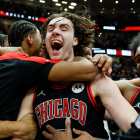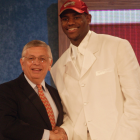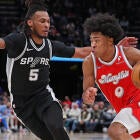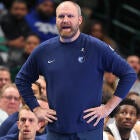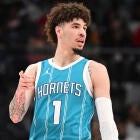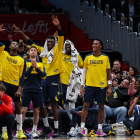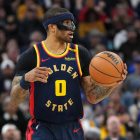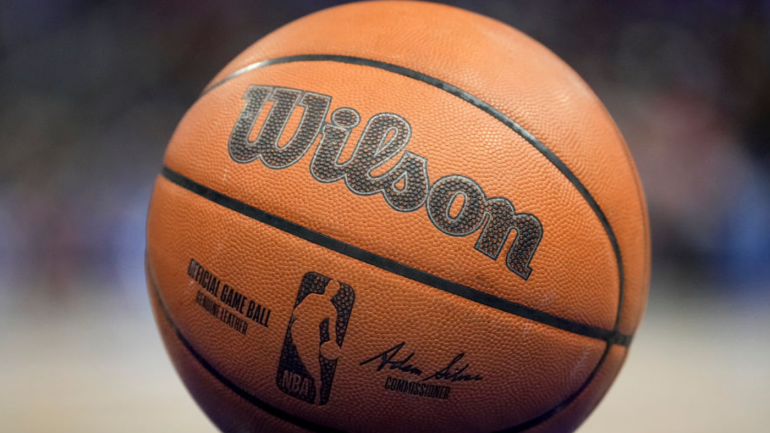
Most sports use a relatively simple, hard salary cap. The league sets an amount. Teams cannot spend more than that amount. No further explanation needed. The NBA's salary cap is soft, and as such, it is designed to be bent and exploited to such a degree that Golden State could easily wind up paying more than four times the projected cap in total player expenses next season. If you don't either do this for a living or have a law degree, there's a good chance you're going to see a team sign a player in NBA free agency this week and ask yourself how on Earth they can afford to do so.
So to simplify the enormously complicated NBA salary cap, I've written a glossary below to define the most important terms you'll hear when the free agency derby begins on Thursday. This is far from a comprehensive list of every rule and exception that governs the NBA's salary cap, and many of the terms below have been simplified, but if you'd like to explore the cap in more detail, Larry Coon's essential guide to the collective bargaining agreement can be found here and the full text of the collective bargaining agreement itself can be found here.
Presented in alphabetical order, here is our salary cap glossary. One quick note before we begin: specific projections come from Hoops Rumors, but these numbers are not finalized.
Glossary
- Base Year Compensation: A rule that applies to most players who are signed-and-traded. If a signed-and-traded player signs for more than the minimum, gets a raise of 20 percent or more and is joining a team above the cap, then that player's salary, purely for the sake of matching purposes in the trade, is different for the trading and acquiring teams. For the trading team, his outgoing salary counts as only 50 percent of his new salary or 100 percent of his previous salary, whichever number is greater. For the acquiring team, his incoming salary counts for whatever his new salary would be.
- Bi-Annual exception: A cap exception that allows teams to sign a free agent to a contract above the minimum even if they are above the cap. This exception can be used only once every two years, and using it triggers a hard cap. Bi-annual contracts can last two years, and the projected amount for this exception in the 2022-23 season is $4,050,000.
Bird rights: A cap exception that allows teams to go above the salary cap in order to retain their own free agents up to a predetermined salary. The amount a team is allowed to pay its players using Bird rights depends on both his previous salary and how many years he's gone without changing teams through free agency. There are three kinds of Bird Rights.
- Non-Bird rights apply to players who have not changed teams through free agency for only one season. Teams are allowed to offer them up to 120 percent of their previous salary without using another exception.
- Early Bird rights apply to players who have not changed teams through free agency for two seasons. Teams are allowed to offer them up to 175 percent of their previous salary or 105 percent of the average player's salary in the previous season, whichever is greater, without using another exception.
- Full Bird rights apply to players who have not changed teams through free agency for three seasons. Teams are allowed to offer these players anything up to their maximum salary.
Buyout: An agreement between a player that is still under contract and his team to mutually part ways wherein the player agrees to surrender some amount of the salary that he is still owed. The player then becomes an unrestricted free agent once he clears waivers. The player's former salary remains on the team's books as dead money, minus however much he gave up in the buyout.
Cap hold: The placeholder figure a team's own free agent counts against their salary cap until he either signs a new contract or has his rights renounced. This figure varies from player to player based on a variety of factors. So long as a team retains the rights to a player, they are free to use whatever Bird rights they have to go above the cap to re-sign that player. If they renounce that player, his cap hold goes off of the books and they can only re-sign him using a cap exception.
Hard cap: A team salary figure (set at the apron) that, once triggered, cannot be crossed for any reason. A hard cap can be triggered in one of three ways:
- A team uses the non-taxpayer mid-level exception.
- A team uses the bi-annual exception.
- A team acquires a player through a sign-and-trade.
July moratorium: A six-day accounting period at the beginning of July during which the league determines the exact figures for the cap, luxury tax line, exceptions and more. Players and teams are free to negotiate during this period, but no moves can officially be made. No agreements made during this period are technically binding, but they are very rarely broken (with DeAndre Jordan being the most notable example).
Luxury tax: A team salary figure that, once passed, forces the offending team to pay a fine to the league that is then dispersed amongst the teams that stayed below the line. The projected 2022-23 luxury tax line is $149 million. The formula that determines how big that fine is can be found here.
Luxury tax apron: A team salary figure that is typically around $6 million above the tax line that under certain circumstances triggers a hard cap. The projected apron for the 2022-23 season is $155.7 million.
Maximum salary: A player salary figure that determines the highest amount he can be paid. A player's individual maximum salary is based on a combination of experience and accomplishments. There are four types of max contracts:
- The lowest bracket of max contracts allows a player to be paid 25 percent of that season's salary cap in the first year of the deal. Most players with between 4-6 years of experience are eligible for this max. This tier of max contract will be worth a projected $30,500,000 for the 2022-23 season.
- The middle bracket of max contracts allows a player to be paid 30 percent of that season's salary cap in the first year of the deal. Most players with between 7-9 years of experience are eligible for this max, along with 4-6-year players signing extensions with their incumbent teams who have qualified for the Derrick Rose Rule by making an All-NBA team in the most recent season or two of the three most recent seasons, winning Defensive Player of the Year in that same timeframe, or winning MVP in any of the past three seasons. This tier of max contract will be worth a projected $36,600,000 for the 2022-23 season.
- The highest bracket of max contracts, often referred to as the "super max," allows a player to be paid 35 percent of that season's salary cap in the first year of a deal. Any player with 10 or more seasons of experience is eligible for this max, as well as 7-9-year players who have qualified for the Designated Veteran provision by meeting any of the same criteria used for the Derrick Rose Rule, with the added caveat that the player can only sign such a contract with a team that drafted them or traded for them during the first four seasons of their career. This tier of max contract will be worth a projected $42,700,000 for the 2022-23 season.
- Any player is always eligible to earn 105 percent of their salary in the previous season, regardless of whether or not that number exceeds what would otherwise be his maximum salary.
Mid-Level exception: A cap exception that allows teams to sign one or multiple free agents to contracts above the minimum salary even if they are above the cap. There are three different mid-level exceptions. Teams may only use one of them, and the one(s) they have access to depends on their overall finances:
- The cap-room mid-level exception is given to teams that were far enough below the cap to spend cap space on free agents. It can be used to sign contracts no longer than two years, and the projected amount for this exception in the 2022-23 season is $5,329,000.
- The taxpayer mid-level exception can be used by any team operating above the salary cap, but is traditionally used by the most expensive ones. It offers a lower salary, but does not trigger a hard cap. It can be used to sign contracts no longer than three years, and the projected amount for this exception in the 2022-23 season is $6,392,000.
- The non-taxpayer mid-level exception can be used by any team operating above the salary cap, but must be wielded with caution, as any team that does use it is hard-capped at the apron. It can be used to sign contracts for up to four years, and the projected amount for this exception in the 2022-23 season is $10,349,000.
Minimum salary: A player salary figure that determines the lowest amount he can be paid. So long as a team is not hard-capped and has an open roster spot, there is no limit to the number of minimum-salaried players that team can sign. A player's individual minimum salary depends on his experience. With each year of NBA experience a player earns, his minimum increases. For our purposes, two figures matter most:
- The rookie minimum is the figure often given to second-round picks and undrafted players. It rises or falls by whatever percentage the salary cap rises or fell in that same season. The projected rookie minimum salary for the 2022-23 season is $1,004,159.
- The two-year veteran's minimum. When a team signs any player with two or more years of experience to a one-year contract, the team only pays that player the minimum for a second-year player. The NBA reimburses the team for the rest, and the difference does not count against the salary cap. This rule exists to minimize financial bias against older players. Most of the minimum-salary free agents you see sign this offseason will count for this figure. The projected two-year veteran's minimum for the 2022-23 season is $1,811,516.
- Salary cap: A figure that is determined based on league revenue which determines how much money teams are allowed to spend acquiring players through either trades or free agency from other teams without using salary-cap exceptions. A team below the line may spend freely in the free agent or trade markets until it reaches that line. A team above the line can only add salary through either the traded player exception or one of the exceptions we are going to cover below. The projected 2022-23 salary cap is currently $122 million. The final number will be determined during the July moratorium.
- Sign-and-trade: An agreement between a player, his original team and a new team in which the player re-signs with his original team only to be immediately traded to a new one. The acquiring team will then be subjected to a hard cap. The trade must meet the same salary-matching criteria that a typical trade would. The contract must be signed with the original team using either cap space or a cap exception.
- Stretch provision: A mechanism by which teams can waive players that are under contract and stretch the money he is owed across twice the number of years remaining on his contract, plus one. For example: say a player is owed $20 million over two more seasons. If that player is stretched, that team would pay him $4 million per year for the next five years. The player's cap figure lowers accordingly, and he becomes an unrestricted free agent once he clears waivers.
![[object Object] Logo](https://sportshub.cbsistatic.com/i/2020/04/22/e9ceb731-8b3f-4c60-98fe-090ab66a2997/screen-shot-2020-04-22-at-11-04-56-am.png)











